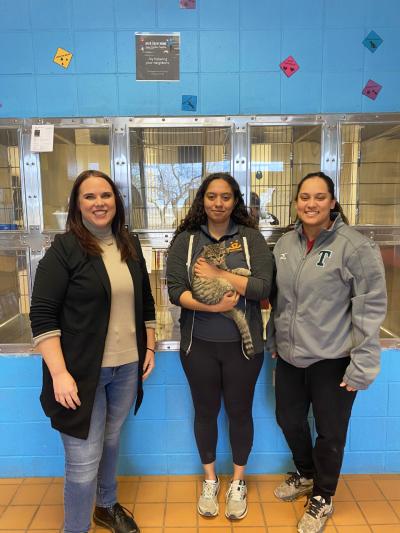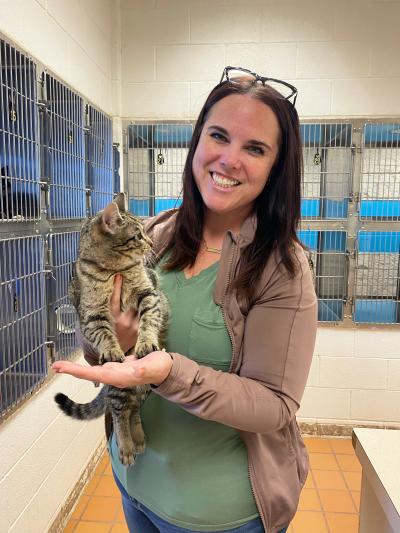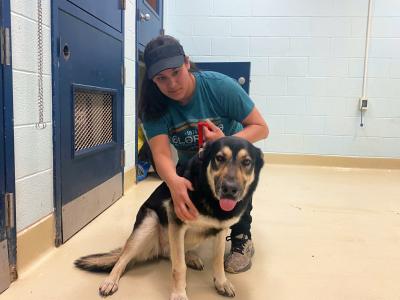Texas animal shelter gets creative to keep pets at home

Imagine you’re walking in your neighborhood when you spot an 80-pound dog with floppy ears and a goofy disposition bouncing by himself down the street. After corralling the friendly pooch, you take him to the animal shelter so the shelter staff can work on finding his people. Now imagine that the shelter staff ask whether you’ll be a “foster finder” and take him home temporarily. They scan the pup for a microchip ID and add his info to their lost/found system, but they also give you supplies and guidance on how to search for his family.
Such programs are becoming more common because they can keep animals out of the shelter and thus support a healthier and less-crowded facility. Programs that reunite lost pets with their families as quickly as possible, ideally without them having to be admitted to the shelter at all, are a key component in reaching no-kill nationwide by 2025. Plus, when finders keep animals in the neighborhoods where they were found, the likelihood of them getting back home — often quickly — increases.
“Lost pets are often found near where they live,” says Paula Powell, Best Friends regional senior manager. “A 2021 study of lost dogs who were eventually reunited with their people found that 70% traveled a mile or less from home while 42% were found a block or less from their home. And cats have been found to be 13 times more likely to return home by means other than going to a shelter. While we’ve gotten in the habit of believing shelters should be solely responsible for reuniting pets with their families, programs like these make perfect sense when you consider the data.”
Such a program certainly made sense for the goofy dog in the above scenario, who was picked up by a good Samaritan and taken to San Angelo Animal Services (SAAS) in Texas. The dog (named Kahuna, by the way) had a microchip, but when his family didn’t answer the phone SAAS was able to convert the finders into temporary foster volunteers through their appropriately named Good Sam program.
“We found the biggest crate we had, so he could be contained safely,” says Morgan Chegwidden, SAAS assistant director of neighborhood and family services. “Once Kahuna’s people got home from work, they connected with the finders and came over to retrieve him. They were so happy Kahuna was safe and that he had avoided the stress of a shelter intake by staying with a nearby family, while Kahuna probably had the best playdate ever.”

Employing multiple strategies to keep families intact
The Good Sam program is hardly SAAS’ first effort to keep animals out of the shelter, which is vital to their goal of helping San Angelo’s most vulnerable: the sick or injured, victims of cruelty or neglect, and pets relinquished by people unable to care for them. They have a counseling program to work with people who inquire about surrendering their pets, and they provide trap-neuter-vaccinate-return (TNVR) services for cats. Over the years they also offered free microchip clinics to increase the odds of lost pets being reunited with their families.
While such moves decreased the number of pets coming into the shelter, in 2022 SAAS found themselves housing about 280 dogs at one time. That meant repurposing spaces in the shelter to accommodate them. But then things shifted over Labor Day when the shelter had to fumigate for pests and put out a plea for short-term foster homes for their dogs.
[First-time dog foster volunteer helps puppy heal]
“More than 100 dogs left that week, and many families extended their commitment to us, which permanently decreased the canine population sheltered here,” Morgan says. “Once we saw that kind of public response, we made the decision to limit our intake this fiscal year to a maximum of 180 dogs and 120 cats in the shelter at any one time.”
Since SAAS had already been working with Paula, Morgan reached out for advice on other ways to help the community’s pets without bringing them into the shelter. Soon after, Leah Long, Best Friends regional senior specialist, spent a week at the organization to assist.
“San Angelo had already been implementing a number of best practices when it came to intake diversion and other lifesaving programs,” Leah says. “Rather than viewing the capacity cap as a barrier to lifesaving, they sought out opportunities to improve and build upon their programs further.”
One of the first programs they reviewed was Good Sam, which first rolled out as a small, voluntary program in 2019. Though it was expanded since then, there were still situations where finders weren’t being successfully converted to temporary foster caregivers. Leah sat down with the staff to explore the reasons why, and they came up with the idea of offering “Good Sam kits” to sweeten the deal.
“Those include everything people might need to care for a dog, as well as a yard sign to display the found animal’s info in the neighborhood,” she says. “It’s not dissimilar from kitten kits, which have been successful in terms of getting people to foster kittens they find. The Good Sam kits have been very helpful at converting more people into stray dog foster caregivers, too, as Morgan just reported she’s had 74 participants this year.”

Coming up with concepts to impact cat numbers
SAAS has also stepped up its efforts to help cats over the past few years, with the most recent work focused on kittens.
“Last year we missed a 90% save rate by 243 animals, all of whom were neonatal kittens,” Morgan says. “There’s no way to manage medical needs, bottle-feed, and otherwise provide appropriate care to such vulnerable kittens in a government shelter like ours.”
SAAS ramped up TNVR to focus on the areas where most of the kittens came from in 2022, but again there was room — and need — for more growth. During her visit, Leah introduced them to Wait Until 8 programming.
“This encourages the public to hang on to kittens until they are 8 weeks of age, old enough to be spayed or neutered and placed up for adoption,” Leah says. “Those foster volunteers also receive a humane trap to catch the mother so she can be spayed, and people who are open to trying to find homes for the kittens on their own receive help with adoption marketing.”
[Amazing progress at Brownsville animal shelter]
The final piece Leah has been helping with is “normalizing leaving kittens with mom, which is still not a common concept with the public,” she says. “SAAS has been working with Concho Valley Paws, their nonprofit partner, to start an informational campaign on social media and with local news to tell the public what to do when they find kittens outside.”
Among the tips: Before you assume a litter of kittens has been orphaned, sprinkle a ring of flour around them. If a mom cat is around and comes back to check on them, she’ll leave footprints in the flour.
“The impulse to bring newborn kittens into the shelter, especially when there is a mom around to raise them, is not their best option for survival,” says Morgan. “Taking the time to communicate that with the public is a good investment of time and energy, and the numbers prove it. Hot off the presses: We just ended our fiscal year and have seen a 46.7% decrease in intake of kittens compared to last year, from 597 last year to only 318 this year!”

Preparing for what’s next
On the horizon for SAAS is a plan to install kiosks with solar-powered microchip scanners in city parks within the neighborhoods where most stray pets come from. The shelter is also gearing up to recruit more short-term foster volunteers during an upcoming facility improvement project.
Leah points out that SAAS’ success so far is a combination of good programs and a good attitude, and Paula has told Morgan that “the nation is watching San Angelo as a template to be duplicated by other shelters in rural, midsize cities.”
“I’m humbled and honored,” Morgan says. “While I sometimes worry about what the future of lifesaving in my community looks like, after eight years of increasingly prioritizing so many programs at SAAS I believe that lifesaving is truly knitted into the quilt of San Angelo’s priorities.”

Let's make every shelter and every community no-kill by 2025
Our goal at Best Friends is to support all animal shelters in the U.S. in reaching no-kill by 2025. No-kill means saving every dog and cat in a shelter who can be saved, accounting for community safety and good quality of life for pets.
Shelter staff can’t do it alone. Saving animals in shelters is everyone’s responsibility, and it takes support and participation from the community. No-kill is possible when we work together thoughtfully, honestly, and collaboratively.






